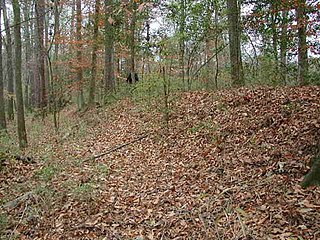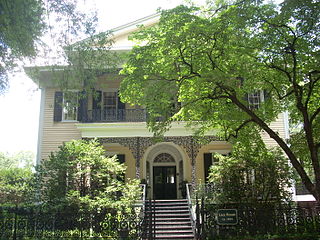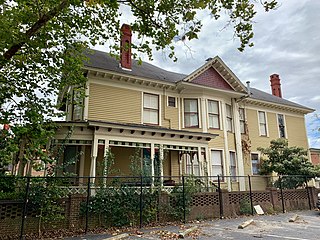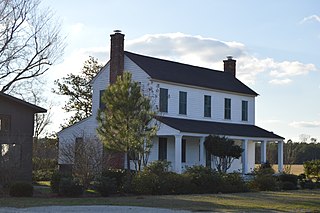Related Research Articles
Keziah or Kezia is a Hebrew name. Keziah was a daughter of Job in the Hebrew Bible. A number of etymologies have been suggested, among them the Hebrew term for the spice tree Cassia.

John Jacob Calhoun Koon Farmstead is a historic home and farm located near Ballentine, Richland County, South Carolina, USA. The house was built in about 1890, and is a two-story farmhouse with a two-tiered Victorian influenced wraparound porch. It has a one-story, gable roofed frame rear addition. Also on the property are the contributing frame grain barn, a frame cotton house, a frame workshop/toolhouse, a late-19th century shed, a planing shed and a sawmill.
Goodwill Plantation is a historic plantation and national historic district located near Eastover, Richland County, South Carolina. The district encompasses 10 contributing buildings and two contributing structures. They include the millpond and a portion of the canal irrigation system ; the overseer's house ; the 2-1/2-story frame mill building ; two slave cabins ; a blacksmith shop; the late-19th century main house; a lodge ; and a carriage house, tenant house, barn and corn crib.

John J. Kaminer House is a historic home located at Gadsden, Richland County, South Carolina. It was built about 1880, and is a 1 1/2-half-story, five bay, frame cottage with a one-story rear ell. It is sheathed in weatherboard and has a gable roof with dormers. It features a shed-roofed front porch with cast-iron porch balusters.
Magnolia, now known as Wavering Place also previously known as the Francis Tucker Hopkins House, is a historic plantation house located near Gadsden, Richland County, South Carolina. It was built about 1855, and is a two-story, Greek Revival style frame building with a full stuccoed brick basement and weatherboard siding. The front facade features a portico with columns rest on tall stuccoed pedestals. Also on the property are a brick kitchen/office, a frame smokehouse and two one-story frame slave houses.
Oakwood, also known as Trumble Cottage, is a historic plantation house located near Gadsden, Richland County, South Carolina. It was built in 1877, and is a 1+1⁄2-story, vernacular Victorian frame cottage with Queen Anne style details. The front façade features a one-story porch with scroll-sawn brackets and a highly ornamented gabled dormer. Also on the property are two slave cabins, a double pen log barn, a corn crib, a frame well house, and another storage building.
Hopkins Graded School, also known as Old Hopkins School, is a historic school building located at Hopkins, Richland County, South Carolina. It was built about 1897, as a one-teacher school. It is a rambling, one-story, "L"-shaped, frame building with weatherboard siding and a gable roof. It features a small square belfry with a pyramidal roof. A new school was constructed across the street about 1914, and the old school was subsequently used as a teacherage.

Kensington Plantation House is a historic plantation house located near Eastover, Richland County, South Carolina. It was built between 1851 and 1853, by Colonel Richard Singleton, a brother of Angelica Singleton Van Buren, daughter-in-law of President Martin Van Buren. The wood frame dwelling consists of a 2+1⁄2-story, central section with a Second Empire style copper covered dome, flanked by lower wings with arched colonnades. The front entrance features a porte-cochere with Corinthian order arches and pilasters.
Big Lake Cattle Mound is a historic earthen mound located in Congaree National Park near Hopkins, Richland County, South Carolina. It was built by settlers in the Congaree Swamp to provide a place of refuge for hogs, cattle, and other grazing animals during the flood season. The Big Lake Cattle Mount measures 75 feet long by 35 feet wide, with a 2 foot tall flat top.
Brady's Cattle Mound is a historic earthen mound located in Congaree National Park near Hopkins, Richland County, South Carolina. It was built about 1900 by settlers in the Congaree Swamp to provide a place of refuge for hogs, cattle, and other grazing animals during the flood season. Brady's Cattle Mount is an oval mound measuring approximately 300 feet in diameter, with a 6 to 7 foot tall flat top. It remains in use.
Cattle Mound No. 6, also known as Georgia Pacific Cattle Mound, is a historic earthen mound located in Congaree National Park near Hopkins, Richland County, South Carolina. It was built by settlers in the Congaree Swamp to provide a place of refuge for hogs, cattle, and other grazing animals during the flood season. Cattle Mound No. 6 is an oval mound measuring approximately 400 feet in diameter, with an 8 to 10 foot tall flat top.

Northwest Boundary Dike is a historic earthen dike located near Hopkins, Richland County, South Carolina. It was built about 1840 by settlers in the Congaree Swamp to control the periodic flooding of the Congaree River and utilize the fertile swampland. The Northwest Boundary Dike measures approximately 10-to-30-foot-wide-by-5-foot-high, and runs for approximately 2000 feet.
Hopkins Family Cemetery is a historic family cemetery located near Hopkins, Richland County, South Carolina. It was established about 1775, on the Back Swamp Plantation. A wall and stile were built about 1835–1837. It contains 69 marked graves of the Hopkins and related families.

Lace House, also known as the Robertson House, is a historic home located at Columbia, South Carolina. It was built in 1854, and is a two-story, five bay, frame dwelling on an English basement. It features a two-story, projecting front porch with ornate cast iron porch supports, and lace-like railings and trim.

Caldwell–Hampton–Boylston House is a historic home located at Columbia, South Carolina. It was built between 1820 and 1830, and is a three-story, five bay, clapboard clad frame dwelling in the Greek Revival style. It features a two-story, projecting front porch. Also on the property is contributing ironwork and brick fencing, and a stable/carriage house, garden gazebo, and tea house. In 1874–1876, it was the residence of South Carolina Reconstruction governor Daniel H. Chamberlain, who purchased the house in 1869.

Moore-Mann House is a historic home located at Columbia, South Carolina. It built about 1903, and is a 2+1⁄2-story, irregular plan, Queen Anne style frame dwelling. It features a one-story verandah, bay windows, decorative shingles and an arched entrance. It was designed by W. B. Smith Whaley, Co., a prominent Columbia architectural and engineering firm, whose owner also built the W. B. Smith Whaley House.
Laurelwood is a historic plantation house located in rural Richland County, South Carolina, near the city of Eastover. It was built about 1830, and is a two-story frame dwelling with a central-hall, double-pile plan. The front façade features a two-tier, three bay, pedimented portico in the Greek Revival style. It has a one-story, frame addition built in the early-20th century. Also on the property ate the contributing frame smokehouse and a frame barn. Also notable is the survival of a slave quarters.
Myrtle Moor is a historic plantation house located near Sumter, Sumter County, South Carolina. It was built about 1825–1840, and is a large, two-story, "L"-shaped" frame farmhouse embellished with vernacular interpretations of the Federal and Greek Revival styles.. The front façade features a one-story full shed roof porch supported by six chamfered wooden posts. Also on the property are the contributing commissary, a barn, and a speculated servant's quarters/kitchen.

Black Rock Plantation House, also known as the Allen-Love House, is a historic plantation house located near Riegelwood, Columbus County, North Carolina. It was built about 1845, and is a two-story, five-bay, braced frame I-house with Federal / Greek Revival style interior design elements. The house is sheathed in weatherboard and has a gable roof. It has a rear shed roof addition and a replacement one-story shed roofed front porch. The house was renovated in 2013.
John Hopkins was Lieutenant Governor of South Carolina from December 1806 until 1808.
References
- 1 2 "National Register Information System". National Register of Historic Places . National Park Service. July 9, 2010.
- ↑ unknown (n.d.). "Keziah Goodwyn Hopkins Brevard House" (pdf). National Register of Historic Places - Nomination and Inventory. Retrieved 2014-01-07.
- ↑ "Keziah Goodwyn Hopkin Brevard House, Richland County (Address Restricted)". National Register Properties in South Carolina. South Carolina Department of Archives and History. Retrieved 2014-01-07.
- ↑ "Keziah Brevard Journal, 1860-1861" . Retrieved 4 October 2014.

